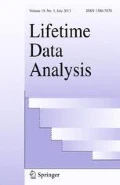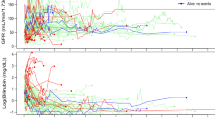Abstract
Duration time models often should include correlated failure times, due to clustered data. These random effects hierarchical models sometimes are called “frailty models” when used for survival analyses. The data analyzed here involve such correlations because patient level outcomes (the times until graft failure following kidney transplantation) are observed, but patients are clustered in different transplant centers. We describe fitting such models by combining two kinds of software, one for parametric survival regression models, and the other for doing Poisson regression in a hierarchical setting. The latter is implemented by using PRIMM (Poisson Regression and Interactive Multilevel Modeling) methods and software (Christiansen & Morris, 1994a). An illustrative example for profiling data is included withk=11 kidney transplant centers andN=412 patients.
Similar content being viewed by others
References
M. Aitkin and D. Clayton, “The fitting of exponential, Weibull, and extreme value distributions to complex censored survival data using GLIM,”Applied Statistics vol. 29(2) pp. 156–163, 1980.
J. E. Anderson and T. A. Louis, N. V. Holm and B. Harvald, “Time-dependent association measures for bivariate survival distributions,”Journal of the American Statistical Association vol. 87(419) pp. 641–650, 1992.
C. L. Christiansen and C. N. Morris, “Hierarchical Poisson regression modeling,” Technical Report, Harvard Medical School, Department of Ambulatory Care and Prevention, 1994a.
C. L. Christiansen and C. N. Morris, “README document,” June 7, 1994, a 7-page tutorial for PRIMM, available through anonymous ftp to hustat.harvard.edu, 1994b.
C. L. Christiansen and C. N. Morris,Fitting and Checking a Two-level Poisson Model: Modeling Patient Morality Rates in Heart Transplant Patients, Marcel Decker, D. Berry and D. Stangl, editors (to appear, 1996).
D. Clayton, “A Monte-Carlo method for Bayesian inference in frailty models,Biometrics vol. 47 pp. 467–485, 1991.
B. Efron and C. Morris, “Stein's estimation rule and its competitors—an empirical Bayes approach,”Journal of the American Statistical Association vol. 34(38) pp. 117–130, 1973.
Health Resources and Services Administration, “Report of Center-Specific Grant and Patient Survival Rates.” 5 vol. report, U.S. Department of Health and Human Services, 1992.
P. Hougaard, “Survival models for heterogeneous populations derived from stable distributions,”Biometrika vol. 73(2) pp. 387–396, 1986.
W. J. Huster, R. Brookmeyer and S. G. Self, “Modelling paired survival data with covariates,”Biometrics vol. 45 pp. 145–146, 1989.
W. James and C. Stein, “Estimation with Quadratic Loss,” inProceedings of the Fourth Berkeley Symposium on Mathematical Statistics and Probability, vol. 1, University of California Press, Berkeley, 1961, pp. 361–379.
J. F. Lawless, “Regression methods for Poisson process data,”Journal of the American Statistical Association, vol. 82(399) pp. 808–815, 1987.
D. V. Lindley and A. F. M. Smith, “Bayes estimates for the linear model,”Journal of the Royal Statistical Society Ser. B, vol. 34 1–41, 1972.
C.-H. Liu and D. B. Rubin, “The ECME algorithm: A simple extension of EM and ECM with faster monotone convergence,”Biometrika vol. 81(4) pp. 633–648, 1994.
P. McCullagh and J. A. Nelder,Generalized Linear Models, second edition, Chapman and Hall, 1989.
C. N. Morris, “Approximating posterior distributions and posterior moments,” inBayesian Statistics 3, J. M. Bernardo, M. H. DeGroot, D. V. Lindley and A. F. M. Smith (eds.), Oxford University Press, pp. 327–344, 1988.
C. Morris, E. Norton and X. H. Zhou, “Parametric duration analysis: A case study of its use applied to nursing home data,” accepted for publication inCase Studies in Biometry, John Wiley, ENAR, Chapter 12 (16 pp.), 1993.
G. B. Nielsen and R. D. Gill, P. K. Andersen and T. I. A. Sorensen, “A counting process approach to maximum likelihood estimation in frailty models,”Scandinavian Journal of Statistics vol. 19 pp. 25–43, 1992.
D. Oakes, “Bivariate survival models induced by frailties,”Journal of the American Statistical Association vol. 84(406) pp. 487–493, 1989.
A. Pickles and R. Crouchley, “A comparison of frailty models for multivariate survival data,”Statistics in Medicine vol. 14 pp. 1447–1461, 1995.
D. Sinha, “Semiparametric Bayesian analysis of multiple event time data,”Journal of the American Statistical Association vol. 88 pp. 893–979, 1993.
A. A. Skolnick, “Are there too many US transplantation centers? Some experts suggest fewer, cheaper, and better,”JAMA vol. 271(14) pp. 1062–1063, 1994.
L. Tierney,LISP-STAT, An Object-Oriented Environment for Statistical Computing and Dynamic Graphics, John Wiley & Sons, Inc., 1990.
J. T. Wassell, “A bivariate survival model with modified Gamma frailty for assessing the impact of interventions,”Statistics in Medicine vol. 12 pp. 241–248, 1993.
L. J. Wei, “The accelerated failure time model: A useful alternative to the Cox regression model in survival analysis,”Statistics in Medicine vol. 11 pp. 1871–1879, 1992.
Author information
Authors and Affiliations
Rights and permissions
About this article
Cite this article
Morris, C., Christiansen, C. Fitting Weibull duration models with random effects. Lifetime Data Anal 1, 347–359 (1995). https://doi.org/10.1007/BF00985449
Issue Date:
DOI: https://doi.org/10.1007/BF00985449




